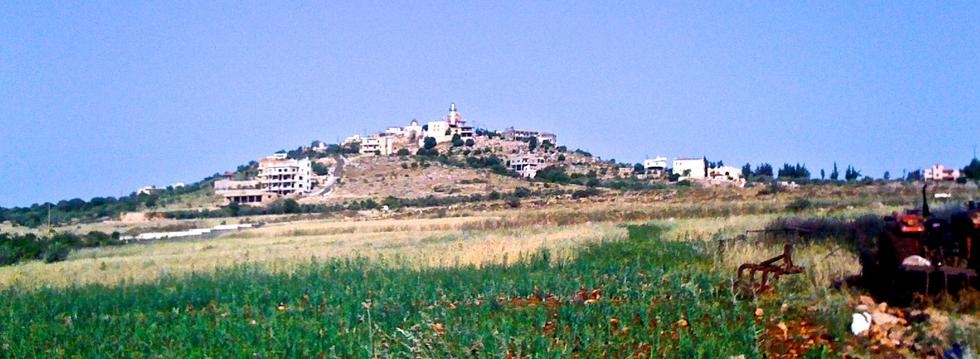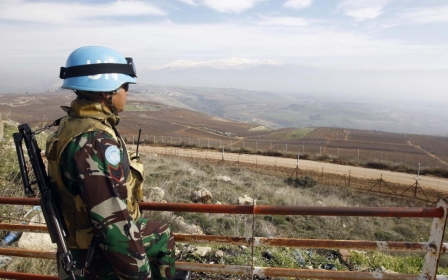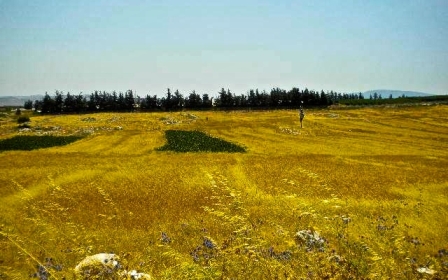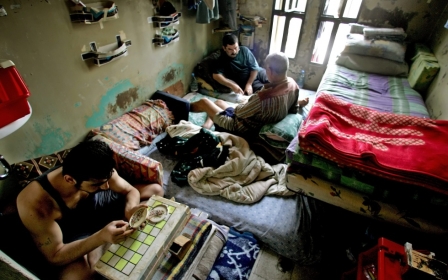
Turning a south Lebanese village into Israel’s next target
As we approach 25 May - the 15th anniversary of Israel’s forced withdrawal from Lebanon following a nasty 22-year occupation - it seems the Israelis are itching for another showdown.
This, at least, is the hunch one gets after perusing Isabel Kershner’s recent New York Times dispatch, datelined Tel Aviv: “Israel Says Hezbollah Positions Put Lebanese at Risk.”
An example of militarised journalism par excellence, it reads a bit like a press release for the Israel Defense Forces, in which Israeli army officials and experts sound off on Hezbollah’s alleged activities in south Lebanon.
Kershner makes a half-hearted attempt to glaze her report with a veneer of impartiality by continually casting the allegations as what “Israel says” (e.g. “Israel says the situation is similar in the Gaza Strip, where, it says, Hamas is using the same tactic of hiding its forces among civilians”).
But the fact of the matter is that Israel is given so much space in which to say things that one begins to wonder why the Times doesn’t give up trying to make a buck off of subscriptions and instead start invoicing the IDF for PR services.
The piece begins with Kershner hovering vicariously over a village in south Lebanon, one of two hamlets with the misfortune to be targeted by name:
“Viewed from the air, Muhaybib looks like a typical southern Lebanese village - a cluster of about 90 houses and buildings punctuated by the minaret of a mosque and surrounded by fields.”
Normalcy lasts only a split second, and we move in for the kill: “But when the Israeli military trains its lens on that hilltop Shiite village close to the border, it sees nine arms depots, five rocket-launching sites, four infantry positions, signs of three underground tunnels, three anti-tank positions and, in the very center of the village, a Hezbollah command post.”
Hezbollah’s wanton militarisation of Muhaybib and other southern Shiite villages is, we are told, supposedly illustrated in maps and aerial photography handed over to the Times by Israel, which “says this amounts to using [village] civilians as a human shield”.
The paper has included a few of these damning graphics for our viewing pleasure. Without the trusted guidance of the IDF, photographs of a door, some rocks, and a hole in the ground might have seemed slightly more innocuous in nature.
Setting the stage
The precision with which Israel has purported to tally Muhaybib’s militant amenities -nine arms depots, four infantry positions - confers an apparent truthfulness upon the allegations. These things have been counted, therefore they must exist.
But when it comes to intelligence gathering, precision has never been Israel’s forte. Rather, a seemingly wilful imprecision has enabled the slaughter of everyone from children playing football in the Gaza Strip to civilians sheltering at a United Nations base in Qana, south Lebanon. Hardly exceptions to the rule, these sorts of massacres have become standard operating procedure.
The latter episode, which took place in 1996 with the help of an Israeli drone and killed more than 100 people, is incidentally mentioned in Kershner’s article during one of her brief trespasses into the opposing viewpoint.
An important question is thus raised: given the IDF’s homicidal behavioural patterns, why assist journalistically in paving the way for further atrocities without vetting the information provided by said homicidal army?
Think of it this way: If ISIS were to hand you pictures of a cheese grater and tell you it’s a satellite image of chemical weapons belonging to Bashar al-Assad, you wouldn’t take their word for it. But more on this subject later.
Kershner never specifies what variety of Israeli “lens” was used to assess the topography of Muhaybib, but the IDF presumably has plenty of lenses to choose from, thanks to its near-constant violation of Lebanese airspace with drones, supersonic jets, and other anxiety-inducing objects.
Whatever model it was, the lens did a bang-up job. Muhaybib is, it seems, just the tip of the iceberg of south Lebanon’s Hezbollah-fication. In the nearby village of Shaqra, home to approximately 4,000 people, the lens has identified “about 400 military sites and facilities belonging to Hezbollah”, writes Kershner.
And that’s not all. Continuing her reckless flyover of Lebanese territory, Kershner reports: “Zooming out over a wider section of southern Lebanon, the Israeli military says the number of potential targets for Israel in and around villages runs into the thousands”.
In portraying the area as up to its ears in Hezbollah, Kershner and her pen are, of course, preemptively justifying the Israeli elimination of each and every one of those targets - and whatever collateral damage that might entail.
Promiscuous projectiles
By this point in the article, many readers might be wondering how it is that Hezbollah has managed to cram one military site per 10 people into parts of the country. As I pointed out in a recent post for Jacobin Magazine, the elevated estimates of military-sites-per-capita may have something to do with Israel’s documented inability to distinguish Lebanese milk factories from Hezbollah command centres.
And although the IDF is endeavouring to attract attention by portraying the alleged conversion of civilian areas into military compounds as a new and dangerous threat, they’ve been saying the same thing for years.
Back in July of 2006, when Israel launched a 34-day assault on Lebanon that killed 1,200 people - the majority of them civilians - Israeli foreign minister Tzipi Livni made creative excuses for the IDF’s glaring lack of surgical precision.
According to Livni, Israeli intelligence had determined that many south Lebanese civilians had Katyusha rockets and other varieties stored under their beds: “When you go to sleep with a missile, you might find yourself waking up to another kind of missile.” Ah, those promiscuous projectiles.
Now, it seems, the cohabitation between civilians and military hardware has become so entrenched that you don’t even need to be sleeping with a Lebanese missile to be fair game for an Israeli one; merely existing in the area suffices. Kershner quotes Israel’s former chief of military intelligence, Amos Yadlin, on the decreasing options for civilian identity in south Lebanon: “We already made it clear in 2006 that people in the villages do not have immunity if we have intelligence that they intend to fire at Israel.”
Bye bye, Geneva Conventions - not that Israel was ever beholden to them in the first place. One of the many problems with Yadlin’s oh-so-sophisticated logic is that it authorises collective punishment based on the supposition that the Israelis are endowed with some omniscient capacity to detect intent. Ergo, an arsenal amassed to defend Lebanon from Israel’s predatory and punitive policies is appraised as offensive in nature, thereby justifying further punitive measures by Israel.
Another complication stems from Israel’s modus operandi vis-à-vis persons who are quite clearly not intending to fire at Israel, such as the 23 civilians - mainly children - who in July 2006 were massacred at close range by Israeli helicopter while fleeing their homes in south Lebanon. They were doing so under Israeli orders.
South Lebanon in three easy steps
After 11 paragraphs of faithfully transmitting the Israeli line re the current state of Hezbollahlandia, Kershner admits in her article that “the Israeli claims could not be independently verified”.
And there we have, plain as day, the reason the thing shouldn’t have been written in the first place. But it was written, and no stab was taken at a verification process that would have been about as straightforward as it gets.
As I noted at Jacobin, the New York Times happens to possess a vast quantity of resources, among them a bureau in Beirut, Lebanon’s capital city, which is a mere two hours’ driving time from the south of the country.
Why no one from said bureau could have undertaken this drive prior to the publication of such an explosive piece is perplexing, particularly since a note at the bottom of the article specifies that “Anne Barnard contributed reporting from Beirut”.
Had Barnard or someone else been dispatched on a reconnaissance mission, the piece might have acquired a more balanced perspective - or at least a sentence along the lines of: “During a visit to Muhaybib, south Lebanon, the New York Times did not trip over any Hezbollah command posts.”
In the event, the newspaper would like to stage a visit at some point in the future, I’d be happy to give them some pointers. I myself rented a car the other day, for 25 dollars, and drove to both Muhaybib and Shaqra. No Israeli-issued map was necessary; I simply proceeded from the south Lebanese city of Tyre up into the hills past the memorial to the Qana massacre victims, and then asked for directions.
The first time I visited this particular section of the south near the Israeli border was shortly after the end of the 2006 war, when a friend and I decided to conduct a hitchhiking tour of Lebanese rubble. In spite of Israeli squawking about Hezbollah’s use of human shields to protect its weaponry, the only armaments on display at the time were ginormous unexploded cluster munitions scattered across select southern thoroughfares - past which two young men who picked us up hitchhiking enjoyed driving at high speeds.
These particular Israeli party favours have long since been removed, though many of the estimated four million cluster bombs with which Israel saturated south Lebanon in the last war continue to litter the landscape in unexploded form, periodically killing and maiming children and other living things. This is an area, in short, in which you might be forgiven for going to sleep with a missile.
Human shields galore
As I approached Shaqra the other morning, a series of Lebanese martyr portraits lining the road reiterated the human toll of Israel’s quest for regional dominance. Inside the village, Shaqra’s current crop of human shields went about their morning routines: going to school, going to the bakery, opening up shops, setting out café tables.
I meanwhile set out in search of the 400 military sites and facilities belonging to Hezbollah, which I did not find, although I did find some houses, some farms, some hair salons and clothing stores, a colourful establishment offering “Botox filling”, an equally colourful establishment called “Magic Land”, a painting of Che Guevara, a pond with rancid water, and a graffito reading “THUG LIFE”.
I then drove on to tiny Muhaybib, the place Kershner describes as “look[ing] like a typical southern Lebanese village” when “viewed from the air”. I arrived to find that, when viewed from the ground, it also looks like a typical Lebanese village.
One human shield, a woman with two mini-human shields in backpacks by her side, waved to me from behind the oversized martyr portrait in front of her house. From a nearby garden, another shield - an elderly woman and thus presumably a repeat offender - grinned widely and directed me down a dead-end road, from which I then emerged with the help of a middle-aged male shield with braces.
At the local mosque, I mistook a martyr portrait for an armed guard, made sure no one had witnessed me ask a poster a question, and headed home.
Along the way I saw plenty of rocks, trees, and doors - some of the featured items in the above graphic accompanying Kershner’s article.
Preemptive strike
Obviously, the point of taking issue with Kershner’s New York Times piece is not to deny that Hezbollah is extremely well armed. They are. But they’re also famously professional and know not to leave their war toys lying around for the IDF “lens” to spy on.
In a 2006 report, Human Rights Watch claimed that, although Hezbollah “occasionally” placed weapons in “populated areas”, these limited cases did “not justify the IDF’s extensive use of indiscriminate force” in its summer assault on Lebanon. And while there was clearly no love lost between HRW and the Party of God, the report “found no cases in which Hezbollah deliberately used civilians as shields to protect them from retaliatory IDF attack”. Furthermore, HRW emphasised that “in none of the cases of [Lebanese] civilian deaths documented in this report is there evidence to suggest that Hezbollah forces or weapons were in or near the area that the IDF targeted during or just prior to the attack”.
But what Kershner has now done, most problematically, is to paint the south Lebanese landscape as so thoroughly and blatantly militarised - its villages teeming with arms depots and the like - that a whole section of the country is lucky if it’s perceived as having a civilian population at all. And the fewer civilians that are perceived to be running around a territory the IDF is longing to blow up, the more leeway it has.
Thanks in part to articles like hers, however, Israel is saved from having to fight this battle alone. The collaborative arrangement hasn’t gone unnoticed by the Israeli newspaper Haaretz, which ran the recent headline: “Israel’s secret weapon in the war against Hezbollah: The New York Times.”
Of course, this is hardly the first time the Times has gone to war on behalf of the Jewish state. Back in 2002, three days prior to Israel’s deadly rampage in the Palestinian town Jenin, foreign affairs columnist Thomas Friedman decreed that “Israel needs to deliver a military blow that clearly shows terror will not pay”.
As veteran British journalist Robert Fisk recalls in The Great War for Civilisation: The Conquest of the Middle East: “Well, thanks, Tom, I said to myself when I read this piece of lethal journalism a few days later. The Israelis certainly followed Friedman’s advice.”
And while Kershner’s intervention is less transparently lethal than Friedman’s, she, too, deserves some thanks. But in her defence, it’s not her fault the US newspaper of record intermittently consents to serve as a propaganda arm for the Israeli military. (As far back as 1982, even Friedman was censored by editors for referring to Israel’s indiscriminate shelling of Muslim West Beirut as indiscriminate.)
Then again, the New York Times is largely a reflection of the views of the establishment, which aren’t too friendly to opponents of Israel. For an example of how these prejudices play out in real life, consider a Times headline from July 2006, 10 days into the Israeli-administered carnage in Lebanon: “U.S. Speeds Up Bomb Delivery for the Israelis.”
Two-tier humanity
The dehumanising discourse deployed in the West against Arabs and Muslims also works in Israel’s favour, with the Israelis cast as “like us”- i.e. inhabiting a superior tier of humanity despite frequently inhuman behaviour.
The upshot is that, if you’re a south Lebanese civilian, there’s a lot you’re up against. In Kershner’s article, you’ve got one solitary “Hezbollah sympathiser” who speaks vaguely in your defense - but it’s his word against those of a whole line-up of Israeli military officials and experts, one of whom warns that “many, many Lebanese will be killed” in the next round of Israel vs Hezbollah.
The blame for the impending deaths is conveniently placed on the latter contender on account of its supremely dangerous military build-up. No regard is paid to the fact that, when it comes to military destruction of life and property, the IDF has the Party of God beat hands down.
Furthermore, Israel isn’t exactly qualified to go around decrying the militarisation of villages given its own existence as one big militarised village with a universal military draft. If we wanted to get nitpicky, we could ask just how “civilian” universally drafted civilians are.
Last year, the Mondoweiss website drew attention to a potential conflict of interest arising from Kershner’s son’s own service in the IDF. With her preemptive strike on south Lebanon, she too has enlisted - and put a new spin, perhaps, on the concept of combat journalism.
- Belen Fernandez is the author of The Imperial Messenger: Thomas Friedman at Work, published by Verso. She is a contributing editor at Jacobin magazine.
The views expressed in this article belong to the author and do not necessarily reflect the editorial policy of Middle East Eye.
Photo: Lebanese border village of Muhaybib (MEE/Belen Fernandez)
Middle East Eye propose une couverture et une analyse indépendantes et incomparables du Moyen-Orient, de l’Afrique du Nord et d’autres régions du monde. Pour en savoir plus sur la reprise de ce contenu et les frais qui s’appliquent, veuillez remplir ce formulaire [en anglais]. Pour en savoir plus sur MEE, cliquez ici [en anglais].





